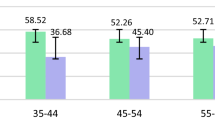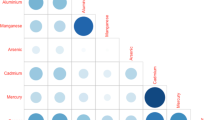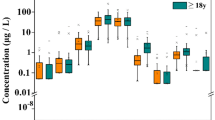Abstract
Environmental exposure to some metals and metalloids has been linked to several health risks, including cancer, and in Mexico it has been poorly studied. Our objective was to describe the urinary concentrations of potentially toxic metal(loids) in a sample of Northern Mexican women, according to selected characteristics. From 998 women living in Northern Mexico that participated in a case–control study, we measured the urinary concentration of potentially toxic elements (arsenic, aluminium, cadmium, chromium, nickel, lead, antimony, cobalt, molybdenum, tin, and vanadium) using matrix-matched calibration standards by Agilent 8800 inductively coupled plasma triple quad (ICP-QQQ). In addition, we obtained information about sociodemographic characteristics and tobacco through an in-person interview. We used QGIS software to geographically locate metal(loid) urinary concentrations within the study area. We also compared the elements with their comparison values (Biomonitoring Equivalents, Biological Exposure Indices, Biological Tolerance Value at the Workplace or Tentative Maximum Permissible Concentration) and used linear regression models to investigate the association of each independent variable with each metal(loid). Participants´ metal(loid) concentrations were above their comparison value of toxicity in 78%, 39% and 7% for arsenic, aluminium, and cadmium, respectively. In addition, 44% of the sample had molybdenum concentrations under the minimal nutritional value. Age, education, body mass index, tobacco use, and state of residence were associated with some metal(loid) concentrations. Besides arsenic, aluminium emerged as a potential relevant environmental contaminant in the study area. Education might be a key element for the prevention and control of metal exposure.



Similar content being viewed by others
Data Availability
Not applicable.
Code Availability
Not applicable.
References
Agency for Toxic Substances and Disease Registry (ATSDR) (2012a) ToxGuide for Chromium, CAS# 7440-47-3
Agency for Toxic Substances and Disease Registry (ATSDR) (2012b) ToxGuide for Vanadium, CAS# 7440–62–2
Agency for Toxic Substances and Disease Registry (ATSDR) (2019) ToxGuide Antimony, CAS# 7440-36-0
Aquino NB, Sevigny MB, Sabangan J, Louie MC (2012) Role of cadmium and nickel in estrogen receptor signaling and breast cancer: metalloestrogens or not? J Env Sci Heal C Env Carcinog Ecotoxicol Rev 30:189–224. https://doi.org/10.1080/10590501.2012.705159
Ashrap P, Sánchez BN, Téllez-Rojo MM et al (2020) In utero and peripubertal metals exposure in relation to reproductive hormones and sexual maturation and progression among girls in Mexico City. Env Res 177:1–28. https://doi.org/10.1016/j.envres.2019.108630
Báez A, Belmont R, García R, Hernández JC (2004) Cadmium and lead levels in deciduous teeth of children living in México City. Rev Int Contam Ambient 20:109–115
Barr DB, Wilder LC, Caudill SP et al (2005) Urinary creatinine concentrations in the U.S. population: implications for urinary biologic monitoring measurements. Environ Health Perspect 113:192–200. https://doi.org/10.1289/ehp.7337
Barr DB, Landsittel D, Nishioka M et al (2006) A survey of laboratory and statistical issues related to farmworker exposure studies. Environ Health Perspect 114:961–968. https://doi.org/10.1289/ehp.8528
Barrios PL, Vázquez-Salas RA, López-Carrillo L et al (2017) Dietary determinants of urinary molybdenum levels in Mexican women: a pilot study. Salud Publica Mex 59:548–555. https://doi.org/10.21149/8162
Briffa J, Sinagra E, Blundell R (2020) Heavy metal pollution in the environment and their toxicological effects on humans. Heliyon 6:1–26. https://doi.org/10.1016/j.heliyon.2020.e04691
Cabrera-Arcega F, Fargher L, Quesadas-Rojas M et al (2018) Environmental exposure of children to toxic trace elements (Hg, Cr, As) in an Urban Area of Yucatan, Mexico: Water, Blood, and Urine Levels. Bull Environ Contam Toxicol. https://doi.org/10.1007/s00128-018-2306-8
Caravanos J, Dowling R, Téllez-Rojo MM et al (2014) Blood lead levels in Mexico and pediatric burden of disease implications. Ann Glob Heal 80:269–277. https://doi.org/10.1016/j.aogh.2014.08.002
Carrillo-Ponce MDL, Martínez-Ordaz VA, Velasco-Rodríguez VM et al (2004) Serum lead, cadmium, and zinc levels in newborns with neural tube defects from a polluted zone in Mexico. Reprod Toxicol 19:149–154. https://doi.org/10.1016/j.reprotox.2004.07.003
Castro-Larragoitia J, Morton-Bermea O, Pérez-Rodríguez RY et al (2021) Metal ( loid ) exposure on children from a historical metallurgical site. Env Geochem Heal. https://doi.org/10.1007/s10653-020-00795-w
Centers for Disease Control and Prevention (CDC) (2018) Secondhand Smoke (SHS) Facts. https://www.cdc.gov/tobacco/data_statistics/fact_sheets/secondhand_smoke/general_facts/index.htm. Accessed 7 Feb 2021
Chowdhury S, Mazumder MAJ, Al-Attas O, Husain T (2016) Heavy metals in drinking water: occurrences, implications, and future needs in developing countries. Sci Total Environ 569–570:476–488. https://doi.org/10.1016/j.scitotenv.2016.06.166
Di Bella C, Traina A, Giosuè C et al (2020) Heavy metals and PAHs in meat, milk, and seafood from augusta area (Southern Italy): contamination levels, dietary intake, and human exposure assessment. Front Public Health 8:1–15. https://doi.org/10.3389/fpubh.2020.00273
Drexler H, Göen T, Schaller KH (2008) Biological tolerance values: change in a paradigm concept from assessment of a single value to use of an average. Int Arch Occup Environ Health 82:139–142. https://doi.org/10.1007/s00420-008-0331-3
Ettinger AS, Téllez-Rojo MM, Amarasiriwardena C et al (2004) Levels of lead in breast milk and their relation to maternal blood and bone lead levels at one month postpartum. Environ Health Perspect 112:926–931. https://doi.org/10.1289/ehp.6615
Ferrer A (2003) Intoxicación por metals. Metal poisoning. An Sis San Navarra 26:141–153
Finley BL, Monnot AD, Paustenbach DJ, Gaffney SH (2012) Derivation of a chronic oral reference dose for cobalt. Regul Toxicol Pharmacol 64:491–503. https://doi.org/10.1016/j.yrtph.2012.08.022
Fisher AT, López-Carrillo L, Gamboa-Loira B, Cebrián ME (2017) Standards for arsenic in drinking water: implications for policy in Mexico. J Public Health Policy 38:395–406. https://doi.org/10.1057/s41271-017-0087-7
Fortoul TI, Quan-Torres A, Sánchez I et al (2002) Vanadium in ambient air : concentrations in lung tissue from autopsies of Mexico City residents in the 1960s and 1990s. Arch Environ Health 57:446–449. https://doi.org/10.1080/00039890209601436
Freire C, Koifman RJ, Fujimoto D et al (2015) Reference values of cadmium, arsenic and manganese in blood and factors associated with exposure levels among adult population of Rio Branco, Acre, Brazil. Chemosphere 128:70–78. https://doi.org/10.1016/j.chemosphere.2014.12.083
Galicia-Garcia V, Rojas-López M, Rojas R et al (1997) Cadmium levels in maternal, cord and newborn blood in Mexico city. Toxicol Lett 91:57–61
Gamboa-Loira B, Cebrián ME, López-Carrillo L (2020) Arsenic exposure in northern Mexican women. Salud Publica Mex 62:262–269. https://doi.org/10.21149/11085
Genchi G, Carocci A, Lauria G et al (2020) Nickel: Human health and environmental toxicology. Int J Environ Res Public Health 17:1–21. https://doi.org/10.3390/ijerph17030679
Gray KM (2018) From content knowledge to community change: a review of representations of environmental health literacy. Int J Environ Res Public Health 15:1–17. https://doi.org/10.3390/ijerph15030466
Hays SM, Aylward LL, LaKind JS et al (2008a) Guidelines for the derivation of biomonitoring equivalents: report from the biomonitoring equivalents expert workshop. Regul Toxicol Pharmacol 51:4–15. https://doi.org/10.1016/j.yrtph.2008.05.004
Hays SM, Nordberg M, Yager JW, Aylward LL (2008b) Biomonitoring equivalents (BE) dossier for cadmium (Cd) (CAS No. 7440–43-9). Regul Toxicol Pharmacol 51:49–56. https://doi.org/10.1016/j.yrtph.2008.05.008
Hays SM, Aylward LL, Gagné M et al (2010) Biomonitoring equivalents for inorganic arsenic. Regul Toxicol Pharmacol 58:1–9. https://doi.org/10.1016/j.yrtph.2010.06.002
Hays SM, Macey K, Poddalgoda D et al (2016) Biomonitoring equivalents for molybdenum. Regul Toxicol Pharmacol 77:223–229. https://doi.org/10.1016/j.yrtph.2016.03.004
Hernández-Serrato MI, Mendoza-Alvarado LR, Rojas-Martínez R et al (2003) Factors associated with lead exposure in Oaxaca, Mexico. J Expo Anal Environ Epidemiol 13:341–347. https://doi.org/10.1038/sj.jea.7500282
Holden B, Guice EA (2014) An investigation of normal urine with a creatinine concentration under the cutoff of 20 mg/dl for specimen validity testing in a toxicology laboratory. J Forensic Sci 59:806–810. https://doi.org/10.1111/1556-4029.12386
Institute of Medicine (2012) Breast cancer and the environment: a life course approach. The National Academies Press, Washington
International Agency for Research on Cancer(IARC) (2020a) All cancers fact sheet. https://gco.iarc.fr/today/data/factsheets/cancers/39-All-cancers-fact-sheet.pdf. Accessed 30 Dec 2020
International Agency for Research on Cancer(IARC) (2020b) Agents Classified by the IARC Monographs , Volumes 1 – 128. https://monographs.iarc.who.int/list-of-classifications. Accessed 4 Feb 2021
Jaishankar M, Tseten T, Anbalagan N et al (2014) Toxicity, mechanism and health effects of some heavy metals. Interdiscip Toxicol 7:60–72. https://doi.org/10.2478/intox-2014-0009
Järup L (2003) Hazards of heavy metal contamination. Br Med Bull 68:167–182. https://doi.org/10.1093/bmb/ldg032
Kazantzis G (1981) the acute and chronic effects of heavy metal poisoning. In: Vale J (ed) Poisoning diagnosis and treatment. Poisoning, pp 171–175
Klaassen CD (2001) Casarett and doull´s toxicology the basic science of poisons. McGraw-Hill, New York
Klotz K, Weistenhöfer W, Neff F et al (2017) The health effects of aluminum exposure. Dtsch Arztebl Int 114:653–659. https://doi.org/10.3238/arztebl.2017.0653
Kupsco A, Kioumourtzoglou M-A, Just AC et al (2020) Prenatal metal concentrations and childhood cardio-metabolic risk using Bayesian Kernel Machine Regression to assess mixture and interaction effects. Epidemiology 30:263–273. https://doi.org/10.1097/EDE.0000000000000962
Lawrence EM (2017) Why do college graduates behave more healthfully than those who are less educated? J Health Soc Behav 58:291–306. https://doi.org/10.1177/0022146517715671
Lehmler H-J, Gadogbe M, Liu B, Bao W (2019) Environmental tin exposure in a nationally representative sample of U.S. Adults and Children: the National Health and Nutrition Examination Survey 2011–2014. Environ Pollut 240:599–606. https://doi.org/10.1016/j.envpol.2018.05.019
Lewis RC, Meeker JD, Basu N et al (2019) Urinary metal concentrations among mothers and children in a Mexico City birth cohort study. Int J Hyg Environ Health 221:609–615. https://doi.org/10.1016/j.ijheh.2018.04.005
Lima-Rogel V, Romano-Moreno S, López-López EDJ et al (2016) Aluminum contamination in parenteral nutrition admixtures for low-birth-weight preterm infants in Mexico. J Parenter Enter Nutr 40:1014–1020. https://doi.org/10.1177/0148607114550001
Lin SY, Lee HH, Lee JF, Chen BH (2018) Urine specimen validity test for drug abuse testing in workplace and court settings. J Food Drug Anal 26:380–384. https://doi.org/10.1016/j.jfda.2017.01.001
Lombi E, Holm PE (2010) Metalloids, soil chemistry and the environment. In: Jahn TP, Bienert GP (eds) MIPs and their role in the exchange of metalloids. Springer, New York, pp 33–34
López-Carrillo L, Hernández-Ramírez RU, Gandol AJ et al (2014) Arsenic methylation capacity is associated with breast cancer in northern Mexico. Toxicol Appl Pharmacol 280:53–59. https://doi.org/10.1016/j.taap.2014.07.013
López-Rodríguez G, Galván M, González-Unzaga M et al (2017) Blood toxic metals and hemoglobin levels in Mexican children. Env Monit Assess 189:1–6. https://doi.org/10.1007/s10661-017-5886-6
Martinez-Finley EJ, Chakraborty S, Fretham S, Aschner M (2012) Admit one: how essential and nonessential metals gain entrance into the cell. Metallomics 4:593–605. https://doi.org/10.1039/c2mt00185c
Michel-Ramirez G, Recio-Vega R, Lantz RC et al (2019) Assessment of YAP gene polymorphisms and arsenic interaction in Mexican women with breast cancer. J Appl Toxicol. https://doi.org/10.1002/jat.3907
Middleton DRS, Watts MJ, Lark RM et al (2016) Assessing urinary flow rate, creatinine, osmolality and other hydration adjustment methods for urinary biomonitoring using NHANES arsenic, iodine, lead and cadmium data. Environ Health 15:1–13. https://doi.org/10.1186/s12940-016-0152-x
Mijal RS, Holzman CB (2010) Blood cadmium levels in women of childbearing age vary by race/ethnicity. Environ Res 110:505–512. https://doi.org/10.1016/j.envres.2010.02.007
Montes-Castro N, Alvarado-Cruz I, Torres-Sánchez L et al (2019) Prenatal exposure to metals modified DNA methylation and the expression of antioxidant- and DNA defense-related genes in newborns in an urban area. J Trace Element Med Biol 55:110–120. https://doi.org/10.1016/j.jtemb.2019.06.014
Moreno ME, Acosta-Saavedra LC, Meza-Figueroa D et al (2010) Biomonitoring of metal in children living in a mine tailings zone in Southern Mexico: a pilot study. Int J Hyg Environ Health 213:252–258. https://doi.org/10.1016/j.ijheh.2010.03.005
National Research Council (2012) Committee on Potential Health Risks from Recurrent Lead Exposure of DOD Firing-Range Personnel; Committee on Toxicology; Board on Environmental Studies and Toxicology; Division on Earth and Life Studies. https://www.ncbi.nlm.nih.gov/books/NBK206974/. Accessed 4 Feb 2021
Osuna-Martínez CC, Armienta MA, Bergés-Tiznado ME, Páez-Osuna F (2021) Arsenic in waters, soils, sediments, and biota from Mexico: an environmental review. Sci Total Environ 752:142062. https://doi.org/10.1016/j.scitotenv.2020.142062
Palacios Nava ME, Moreno Sánchez AR, Paz Román MDP et al (2018) Situation of occupational and environmental health in Mexico. Ann Glob Health 84:348–359. https://doi.org/10.29024/aogh.2317
Peñoles (2009) Transformamos la adversidad en oportunidades. INFORME ANUAL 2009
Poddalgoda D, Macey K, Jayawardene I, Krishnan K (2016) Derivation of biomonitoring equivalent for inorganic tin for interpreting population-level urinary biomonitoring data. Regul Toxicol Pharmacol 81:430–436. https://doi.org/10.1016/j.yrtph.2016.09.030
Rahimzadeh MR, Rahimzadeh MR, Kazemi S, Moghadamnia AA (2017) Cadmium toxicity and treatment: an update. Casp J Intern Med 8:135–145. https://doi.org/10.22088/cjim.8.3.135
Riojas-Rodríguez H, Schilmann A, López-Carrillo L, Finkelman J (2013) La salud ambiental en México: Situación actual y perspectivas futuras. Salud Publica Mex 55:638–649. https://doi.org/10.21149/spm.v55i6.7310
Rodríguez Flores C, Preciado Puga M, Wrobel K et al (2011) Trace elements status in diabetes mellitus type 2: possible role of the interaction between molybdenum and copper in the progress of typical complications. Diabetes Res Clin Pract 91:333–341. https://doi.org/10.1016/j.diabres.2010.12.014
Sanchez TR, Slavkovich V, LoIacono N et al (2019) Urinary metals and metal mixtures in Bangladesh: exploring environmental sources in the health effects of arsenic longitudinal study (HEALS). Env Int 121:852–860. https://doi.org/10.1016/j.envint.2018.10.031
Schikowski T, Sugiri D, Reimann V et al (2008) Contribution of smoking and air pollution exposure in urban areas to social differences in respiratory health. BMC Public Health 8:1–10. https://doi.org/10.1186/1471-2458-8-179
Secretaría de Salud de México (1995a) Norma Oficial Mexicana NOM-127-SSA1–1994, “SALUD AMBIENTAL, AGUA PARA USO y Consumo Humano-Limites Permisibles de Calidad y Tratamientos a QUE DEBE Someterse el AGUA PARA su Potabilizacion”. Diario Oficial de la Federación
Secretaría de Salud de México (1995b) NORMA OFICIAL MEXICANA NOM-118-SSA1–1994, BIENES Y SERVICIOS. MATERIAS PRIMAS PARA ALIMENTOS, PRODUCTOS DE PERFUMERÍA Y BELLEZA. COLORANTES Y PIGMENTOS INORGÁNICOS. ESPECIFICACIONES SANITARIAS. Diario Oficial de la Federación
Secretaría de Salud de México (1996) NORMA Oficial Mexicana NOM-130-SSA1-1995, Bienes y servicios. Alimentos envasados en recipientes de cierre hermético y sometidos a tratamiento térmico. Disposiciones y especificaciones sanitarias. Diario Oficial de la Federación
Secretaría de Salud de México (1999) Norma Oficial Mexicana NOM-147-SSA1–1996, Bienes y Servicios. Cereales y SUS Productos. Harinas de Cereales, Semolas O Semolinas. Alimentos a Base de Cereales, de Semillas Comestibles, Harinas, Semolas O Semolinas O SUS Mezclas. Productos de Panificacion. Diario Oficial de la Federación
Secretaría de Salud de México (2011) NORMA Oficial Mexicana NOM-242-SSA1-2009, Productos y servicios. Productos de la pesca frescos, refrigerados, congelados y procesados. Especificaciones sanitarias y métodos de prueba. Diario Oficial de la Federación
Secretaría de Salud de México (2019) PROYECTO de Norma Oficial Mexicana PROY-NOM-127-SSA1-2017, Agua para uso y consumo humano. Límites permisibles de la calidad del agua. Diario Oficial de la Federación
Stahl T, Taschan H, Brunn H (2011) Aluminium content of selected foods and food products. Environ Sci Eur 23:1–11. https://doi.org/10.1186/2190-4715-23-37
Tchounwou PB, Yedjou CG, Patlolla AK, Sutton DJ (2014) Heavy metals toxicity and the environment. EXS 101:1–30. https://doi.org/10.1007/978-3-7643-8340-4_6
Téllez-Rojo MM, Bautista-Arredondo LF, Trejo-Valdivia B et al (2019) Reporte nacional de niveles de plomo en sangre y uso de barro vidriado en población infantil vulnerable. Salud Publica Mex 61:787–797. https://doi.org/10.21149/10555
The American Conference of Governmental Industrial Hygienists (2021) Biological Exposure Indices (BEI®) Introduction. https://www.acgih.org/tlv-bei-guidelines/biological-exposure-indices-introduction. Accessed 10 Feb 2021
Torres-Sánchez L, Vázquez-Salas RA, Vite A et al (2018) Blood cadmium determinants among males over forty living in Mexico City. Sci Total Environ 637–638:686–694. https://doi.org/10.1016/j.scitotenv.2018.04.371
Tovar-Sánchez E, Mussali-Galante P, Martínez-Pacheco M et al (2016) Relationship between genotoxic damage and arsenic blood concentrations in individuals residing in an arsenic contaminated area in Morelos, Mexico. Rev Int Contam Ambient 32:101–117
Tyrrell J, Melzer D, Henley W et al (2013) Associations between socioeconomic status and environmental toxicant concentrations in adults in the USA: NHANES 2001–2010. Environ Int 59:328–335. https://doi.org/10.1016/j.envint.2013.06.017
The American Conference of Governmental Industrial Hygienists (2005) Threshold Limit Values for Chemical Substances and Biological Exposure Indices
WHO/HPR/OCH (1996) Biological Monitoring of Chemical Exposure in the Workplace Guidelines. Volume 1
WorkSafe New Zealand (2018) Biological Exposure Indices (BEI) Review. New Zealand Government.
World Health Organization (WHO) (2010) Aluminium in drinking-water. Background document for development of WHO Guidelines for Drinking-water Quality. WHO/HSE/WSH/1001/13
Zhang N, Yang S, Yang J et al (2020) Association between metal cobalt exposure and the risk of congenital heart defect occurrence in offspring: a multi-hospital case-control study. Environ Health Prev Med 25:1–12. https://doi.org/10.1186/s12199-020-00877-2
Acknowledgements
We are deeply grateful to the women that participated in the study and: Leonel Córdoba Gamboa for technical assistance in maps elaboration, Verónica López for coordination of the fieldwork; Reina Collado for administrative support; Rosa Maria Garcia Hernández for laboratory technical assistance; as well as the participating hospitals: in Nuevo León, UMAE H. de Especialidades No. 25 and No. 23 from IMSS, H. Regional “Monterrey” from ISSSTE, Centro Universitario contra el Cáncer, H. Universitario “Dr. José E. González”; in Coahuila, H. de la Mujer and H. General de Torreón from SSA, and UMAE H. de Especialidades 71 from IMSS; in Chihuahua, H. General “Ciudad Juárez” and H. General “Presidente Lázaro Cárdenas” from ISSSTE, and Centro Estatal de Cancerología de Chihuahua from SSA; in Sonora, H. General “Dr. Fernando Ocaranza” from ISSSTE, H. Integral de la Mujer del Estado de Sonora and H. Oncológico del Estado de Sonora from SSA, and UMAE Hospital de Especialidades No. 2 from IMSS; in Durango, Clínica H. “Gómez Palacio” and H General “Dr. Santiago Ramón y Cajal” from ISSSTE, and Centro Estatal de Cancerología de Durango from SSA.
Funding
This study was supported by Consejo Nacional de Ciencia y Tecnología (CONACyT). Fondo Sectorial de Investigación en Salud y Seguridad Social (FOSISS) SALUD-2005-CO2-14373, SALUD-2009-01-111384, SALUD-2010-CO1-140962 and SALUD-2016-1-272632); Fondo Sectorial de Investigación para la Educación 2008-79912 SEP-CONACYT; Proyectos de desarrollo científico para atender problemas nacionales PDCPN2013-01-215464; Fondo Institucional para el Desarrollo Científico, Tecnológico y de Innovación FORDECYT-PRONACES/137732/2020.
Author information
Authors and Affiliations
Corresponding author
Ethics declarations
Conflict of interest
The authors declare that they have no conflict of interest.
Ethical Approval
All procedures performed in the study participants were in accordance with the ethical standards of the research committee of the National Institute of Public Health (Mexico), and with the 1964 Helsinki declaration and its later amendment.
Informed Consent
Informed consent was obtained from all individual participants included in the study.
Additional information
Publisher's Note
Springer Nature remains neutral with regard to jurisdictional claims in published maps and institutional affiliations.
Supplementary Information
Below is the link to the electronic supplementary material.
Rights and permissions
About this article
Cite this article
Mérida-Ortega, Á., Rothenberg, S.J., Cebrián, M.E. et al. Urinary Concentrations of Potentially Toxic Metals and Metalloids Among Women Residing in Northern Mexico. Expo Health 14, 857–870 (2022). https://doi.org/10.1007/s12403-021-00458-w
Received:
Revised:
Accepted:
Published:
Issue Date:
DOI: https://doi.org/10.1007/s12403-021-00458-w




